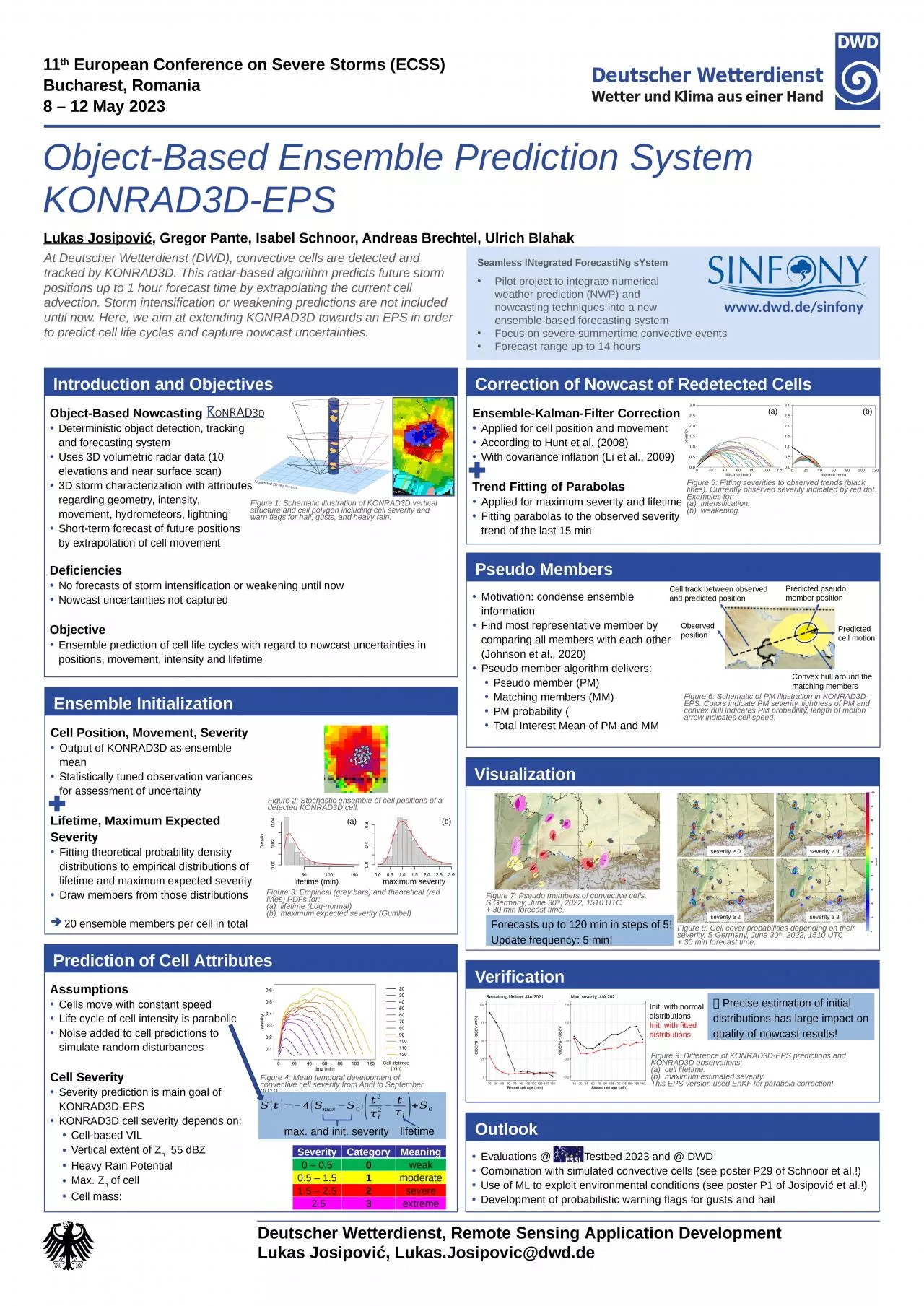

Deterministic object detection tracking and forecasting system Uses 3D volumetric radar data 10 elevations and near surface scan 3D storm characterization with attributes regarding geometry intensity movement hydrometeors lightning ID: 1021926
Download Presentation The PPT/PDF document "Object-Based Nowcasting" is the property of its rightful owner. Permission is granted to download and print the materials on this web site for personal, non-commercial use only, and to display it on your personal computer provided you do not modify the materials and that you retain all copyright notices contained in the materials. By downloading content from our website, you accept the terms of this agreement.
1. Object-Based Nowcasting Deterministic object detection, tracking and forecasting systemUses 3D volumetric radar data (10 elevations and near surface scan)3D storm characterization with attributes regarding geometry, intensity, movement, hydrometeors, lightningShort-term forecast of future positions by extrapolation of cell movementObject-Based Ensemble Prediction System KONRAD3D-EPSLukas Josipović, Gregor Pante, Isabel Schnoor, Andreas Brechtel, Ulrich BlahakDeutscher Wetterdienst, Remote Sensing Application DevelopmentLukas Josipović, Lukas.Josipovic@dwd.deAt Deutscher Wetterdienst (DWD), convective cells are detected and tracked by KONRAD3D. This radar-based algorithm predicts future storm positions up to 1 hour forecast time by extrapolating the current cell advection. Storm intensification or weakening predictions are not included until now. Here, we aim at extending KONRAD3D towards an EPS in order to predict cell life cycles and capture nowcast uncertainties.Introduction and ObjectivesEnsemble InitializationVerificationCorrection of Nowcast of Redetected CellsCell Position, Movement, SeverityOutput of KONRAD3D as ensemble meanStatistically tuned observation variances for assessment of uncertaintyLifetime, Maximum Expected SeverityFitting theoretical probability density distributions to empirical distributions of lifetime and maximum expected severityDraw members from those distributions20 ensemble members per cell in total 11th European Conference on Severe Storms (ECSS)Bucharest, Romania8 – 12 May 2023Seamless INtegrated ForecastiNg sYstemPilot project to integrate numerical weather prediction (NWP) and nowcasting techniques into a new ensemble-based forecasting systemFocus on severe summertime convective eventsForecast range up to 14 hoursFigure 1: Schematic illustration of KONRAD3D vertical structure and cell polygon including cell severity and warn flags for hail, gusts, and heavy rain.DeficienciesNo forecasts of storm intensification or weakening until nowNowcast uncertainties not capturedObjectiveEnsemble prediction of cell life cycles with regard to nowcast uncertainties in positions, movement, intensity and lifetimeFigure 2: Stochastic ensemble of cell positions of a detected KONRAD3D cell.Figure 3: Empirical (grey bars) and theoretical (red lines) PDFs for:lifetime (Log-normal)maximum expected severity (Gumbel)(a)(b)lifetime (min)maximum severityPrediction of Cell AttributesAssumptionsCells move with constant speedLife cycle of cell intensity is parabolicNoise added to cell predictions to simulate random disturbancesCell SeveritySeverity prediction is main goal of KONRAD3D-EPSKONRAD3D cell severity depends on:Cell-based VILVertical extent of Zh 55 dBZHeavy Rain PotentialMax. Zh of cellCell mass: Figure 4: Mean temporal development of convective cell severity from April to September 2019.Cell lifetimes (min)SeverityCategoryMeaning0 – 0.50weak0.5 – 1.51moderate1.5 – 2.52severe 2.53extremeSeverityCategoryMeaning0 – 0.50weak0.5 – 1.51moderate1.5 – 2.52severe3extrememax. and init. severitylifetime Ensemble-Kalman-Filter CorrectionApplied for cell position and movementAccording to Hunt et al. (2008)With covariance inflation (Li et al., 2009)Trend Fitting of ParabolasApplied for maximum severity and lifetimeFitting parabolas to the observed severity trend of the last 15 minPseudo MembersVisualizationFigure 5: Fitting severities to observed trends (black lines). Currently observed severity indicated by red dot. Examples for:intensification.weakening.(a)(b)Motivation: condense ensemble informationFind most representative member by comparing all members with each other (Johnson et al., 2020)Pseudo member algorithm delivers:Pseudo member (PM)Matching members (MM)PM probability (Total Interest Mean of PM and MM Observed positionCell track between observed and predicted positionPredicted pseudo member positionConvex hull around the matching membersPredicted cell motionFigure 6: Schematic of PM illustration in KONRAD3D-EPS. Colors indicate PM severity, lightness of PM and convex hull indicates PM probability, length of motion arrow indicates cell speed.severity ≥ 0severity ≥ 2severity ≥ 1severity ≥ 3Figure 8: Cell cover probabilities depending on their severity. S Germany, June 30th, 2022, 1510 UTC + 30 min forecast time.Figure 7: Pseudo members of convective cells.S Germany, June 30th, 2022, 1510 UTC + 30 min forecast time.Forecasts up to 120 min in steps of 5!Update frequency: 5 min!OutlookEvaluations @ Testbed 2023 and @ DWDCombination with simulated convective cells (see poster P29 of Schnoor et al.!)Use of ML to exploit environmental conditions (see poster P1 of Josipović et al.!)Development of probabilistic warning flags for gusts and hailInit. with normal distributionsInit. with fitted distributionsFigure 9: Difference of KONRAD3D-EPS predictions and KONRAD3D observations:cell lifetime.maximum estimated severity.This EPS-version used EnKF for parabola correction! Precise estimation of initial distributions has large impact on quality of nowcast results!www.dwd.de/sinfony